
Get it all and
save over 70%
- Lifetime access to the entire FilmSkills library
- PLUS... 75 FREE bonus lessons
- PLUS... Get all new content FREE
- PLUS... Personal training
- PLUS... 6 FREE reference books










Why pay $3,388 to buy all FilmSkills courses individually when you can get the library for only
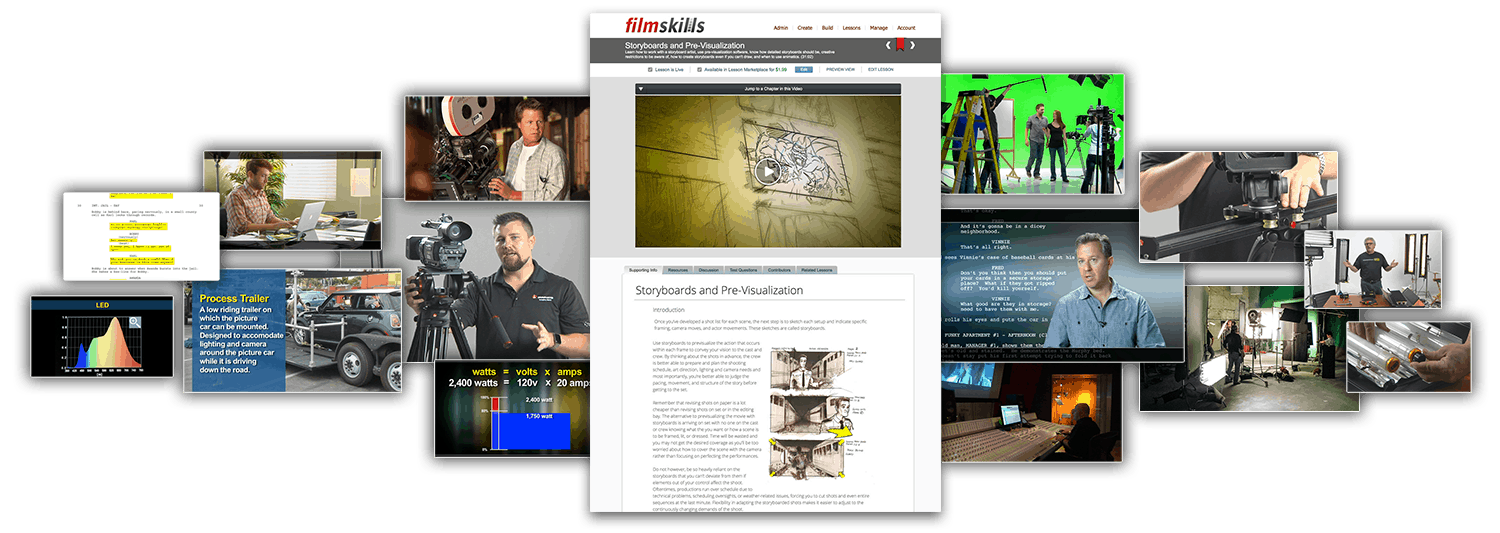
Unlimited Access
Unlock all 325+ high-value video tutorials. Jam packed with over 100 hours of on-the set content, illustrated tutorials, and much more.
FREE Updates
We are constantly producing new videos, and you will be the first to get all new content... and the best part is it's included in your membership!
FREE Downloads
Download hundreds of contracts, forms, and samples you can use on your own productions.
Sample Footage
Download free sample footage to hone your editing skills. We will show you the skills, and now you can practice to improve your craft.
Free E-Books
Get the entire 6-volume filmmaking e-book series in PDF format for reference on set and in the editing room FREE.
Personal Consultation
Your membership includes one hour of one-on-one phone training with one of our instructors. Ask whatever you want!
"I signed up for FilmSkills Unlimited. Absolutely invaluable course. I would go this far and say that this is the best online course on the topic. The catalog is broad and given the range of subject covered, the value is unbelievable. Highly recommended."
– Manoj Jayadevan
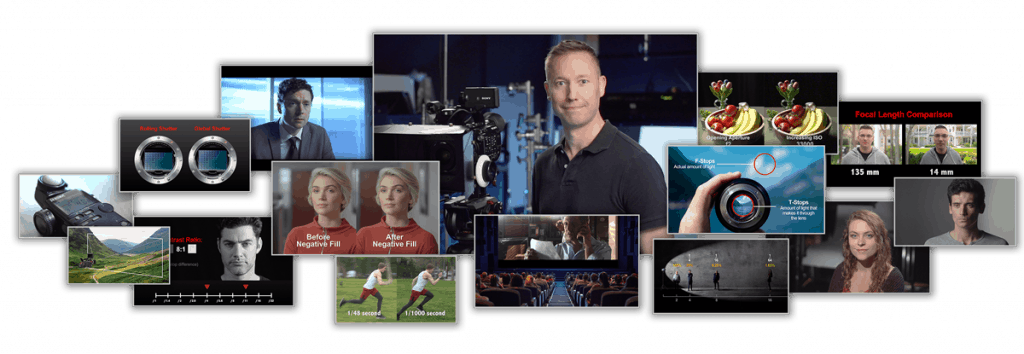
See What's Included
When we say FilmSkills Unlimited covers the ENTIRE filmmaking process, we really mean it.
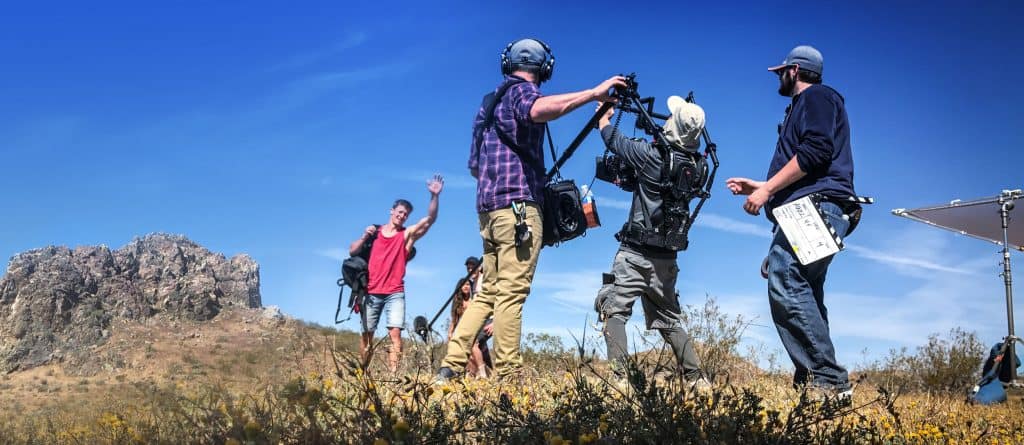
Learn the requirements, challenges, and realities of working in the entertainment industry. Over 150 successful Hollywood filmmakers from all disciplines provide real world advice to help better prepare you for a career in the film industry.
How to Break into the Film Industry | |
|---|---|
Career Advice from the Pros | 21:13 |
How to Get Your First Job | 22:54 |
How to Move to Los Angeles | 18:13 |
How to Make Money in the Film Industry | 24:37 |
Realities of a Career in the Film Industry | 27:18 |
The Art of Networking | 22:17 |
How to Survive in Hollywood | 17:00 |
Working Freelance | 26:14 |
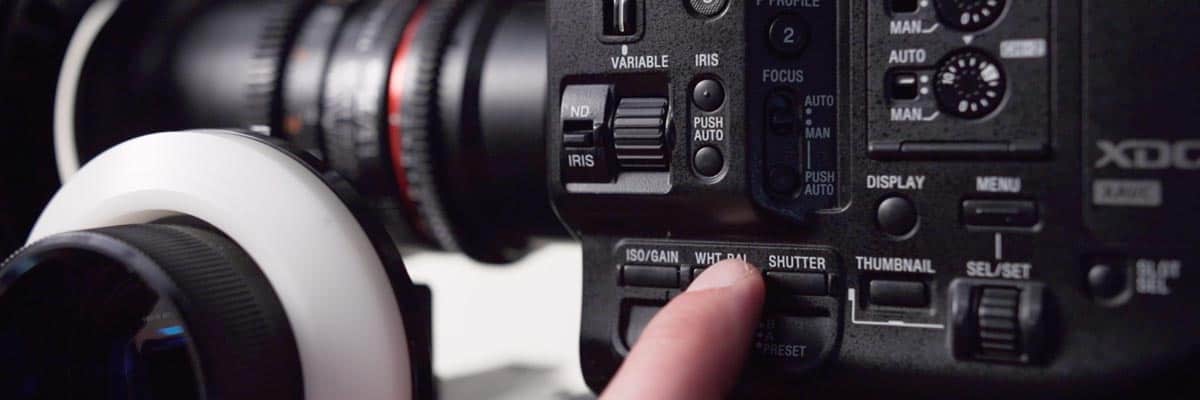
Quick Start lessons have been specifically designed to guide you through basic camera functions, audio recording, and production techniques. Each lesson includes a downloadable and printable quick start guide to help you on set.
Quick Start Lessons | ||
|---|---|---|
Setting Up Your Camera | 12:36 | |
Basic Shooting Techniques | 16:56 | |
Basic Framing Techniques | 16:27 | |
Basic Audio Techniques | 15:21 | |
Bsic Production Techniques | 15:51 | |
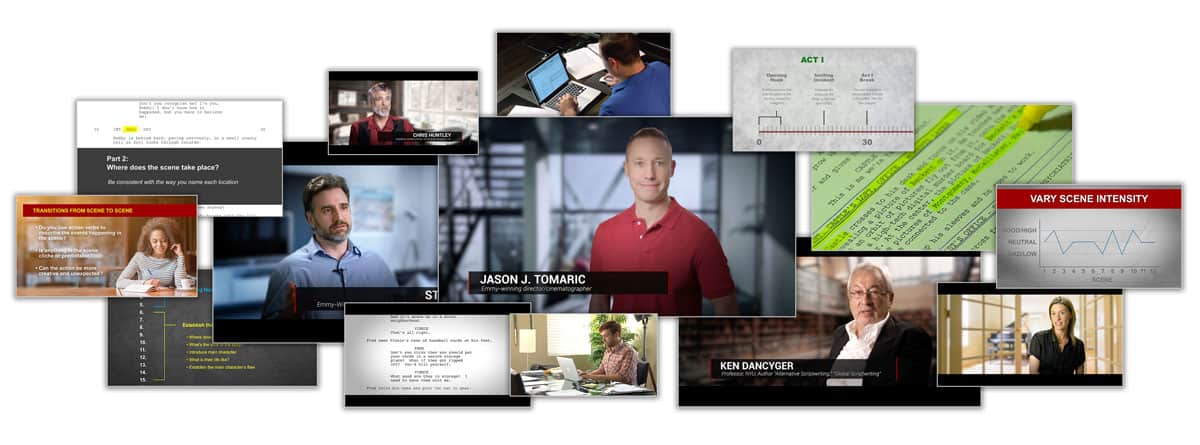
The core screenwriting curriculum is organized into three stages, with all three guiding you through the screenwriting process.
- Section 1: Story Structure – this series of lessons focuses on how to build and structure the story, manage sub plots, and how to address story pacing issues.
- Section 2: Character Development – this series of lessons guides you through the process of creating believable characters, developing strong backstories, and writing convincing dialogue.
- Section 3: The writing process – In this section, learn how to approach the writing process, from outline to rewrites.
Core Screenwriting Curriculum | |
|---|---|
Section 1: Story Structure | |
Lesson 1 – Beginning the Writing Process | – |
Lesson 2 – Working with a Writing Partner | – |
Lesson 3 – Finding Story Ideas and Inspiration | 17:36 |
Lesson 4 – Developing a Marketable Idea | 19:40 |
Lesson 5 – Story Formats | 17:18 |
Lesson 6 – The 7 Plot Types | 20:01 |
Lesson 7 – The Implications of Genre | 16:40 |
Lesson 8 – The Three Act Structure | 39:00 |
Lesson 9 – A-Story and Subplots | 27:52 |
Lesson 10 – Techniques to Improve Story Pacing | 14:40 |
Lesson 11 – Techniques to Engage the Audience | 23:11 |
Section 2: Character Development | |
Lesson 12 – Creating an Amazing Protagonist | 32:08 |
Lesson 13 – Creating the Perfect Antagonist | 23:23 |
Lesson 14 – Conflict Types | 22:33 |
Lesson 15 – How to Write Memorable Supporting Characters | 18:54 |
Lesson 16 – Understanding Character Archetypes | 24:44 |
Lesson 17 – Designing Personality and Building Backstory | 29:06 |
Lesson 18 – How to Write Natural Dialogue | 21:46 |
Section 3: The Writing Process | |
Lesson 19 – Title, Theme, and Log Lines | 15:02 |
Lesson 20 – How to Write a Treatment and Outline | 19:30 |
Lesson 21 – How to Format a Screenplay | 18:13 |
Lesson 22 – How to Write the First Draft | 10:34 |
Lesson 23 – Techniques for Rewriting and Refining Your Script | 13:55 |
Lesson 24 – How to Market Your Script to Producers and Agents | 21:18 |
Lesson 25 – Your Screenplay and the Real World | 17:29 |
Additional Screenwriting Lessons | |
|---|---|
Beginning the Writing Process | – |
Working with a Writing Partner | – |
The Changing Landscape of Television | 34:36 |
Defining and Writing Comedy | 29:36 |
The Hidden Tools of Comedy | 32:02 |
How to Become a Hollywood Writer Part I | 10:53 |
How to Become a Hollywood Writer Part II | 30:12 |
How to Work in a Television Writers Room | 24:40 |
How to Write a Reality Television Show | 22:22 |
Working with Final Draft Software | |
|---|---|
Final Draft – Script Basics | 26:05 |
Final Draft – Using Templates | 13:02 |
Final Draft – Story Organization | 15:21 |
Final Draft – Distributing Your Script | 17:37 |
Final Draft – Tips, Tricks, & Utilities | 28:00 |
Final Draft – Production | 23:15 |

Learn the business of filmmaking, with emphasis on the studio and corporate structures, how to raise and manage money, work with unions, and handle the financial aspects of filmmaking.
Producing and Development | |
|---|---|
The Studio System | 33:09 |
Working for a Studio | 26:19 |
Making a Business Plan | 30:53 |
Packaging Your Movie | 29:29 |
Agents and Managers | 23:37 |
How to Pitch and Sell a Reality TV Show | 28:54 |
How to Raise Money for your Movie | 39:30 |
Taking Advantage of Tax Incentives | 21:54 |
Forming a Production Company | 32:54 |
How to Manage the Budget Money | 36:07 |
Hiring the Crew | 30:31 |
Working with Vendors | 18:34 |
Unions and Guilds | 35:40 |
Working with SAG/AFTRA | 25:47 |

Scheduling and Budgeting | |
|---|---|
Beginning Pre-Production | – |
Breaking Down the Script | 19:11 |
Scheduling the Production | 29:27 |
Scheduling the Day | 30:03 |
How to Build a Budget | 30:45 |
Production Insurance | 19:45 |
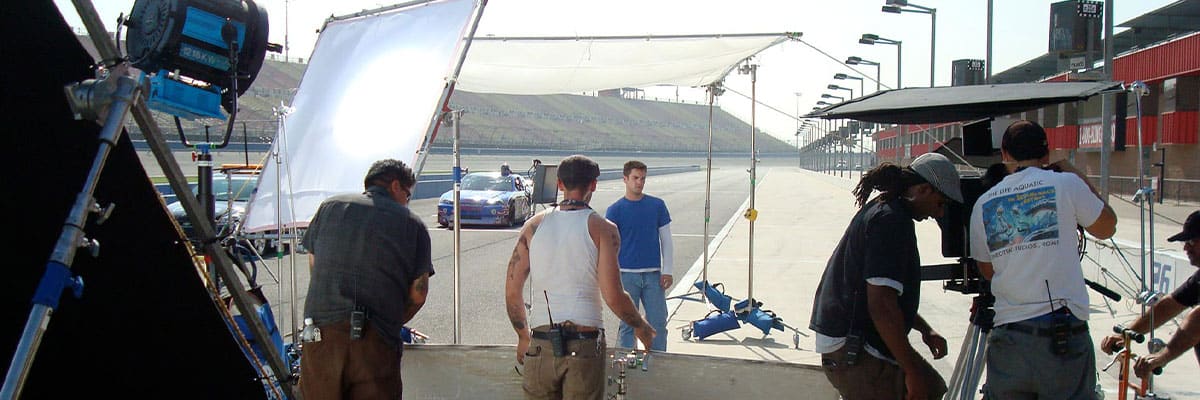
The Crew | ||
|---|---|---|
Crew Structures | – | |
Crew Positions | – | |
The Line Producer | 37:33 | |
The Unit Production Manager | 28:57 | |
Production Coordinator | 19:53 | |
1st Assistant Director | 39:06 | |
2nd Assistant Director | 10:10 | |
2nd 2nd Assistant Director | 5:33 | |
Production Assistants | 31:36 | |
Script Supervisor | 28:44 | |
Production Designer | 21:14 | |
The Art Director | 11:26 | |
Construction Coordinator | 27:52 | |
The Cinematographer | – | |
Camera Operator | 26:13 | |
1st Assistant Camera | 11:24 | |
2nd Assistant Camera | 7:33 | |
Key Grip | 20:45 | |
Best Boy | 11:22 | |
Grips | 12:01 | |
Working as a Grip | 25:16 | |
Dolly Grip | 13:02 | |
Gaffer | 20:10 | |
Best Boy Electric | 9:57 | |
Electricians | 16:19 |
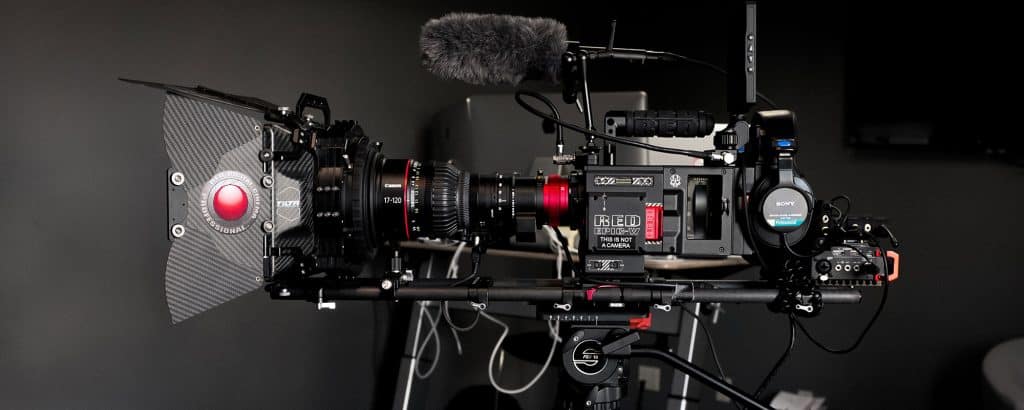
Cinematography | |
|---|---|
An Overview of Cinematography | – |
How a Cinematographer Preps a Project | – |
Camera and Lens | |
|---|---|
Building the Camera Package | – |
How to Prep a Camera | 14:37 |
Imaging Sensor and ISO | 20:25 |
Frame Rates | 20:02 |
Film vs Video | 26:57 |
Tripods and Sliders | 17:58 |
Introduction to Lenses | 22:00 |
Lens Care | 9:28 |
Focusing Techniques | 23:21 |
How to Expose a Shot | 25:16 |
F-stops and T-stops | 17:42 |
The Zone System | 23:03 |
Lens Focal Length | 23:50 |
Depth of Field Tutorial | 27:29 |
Macro Focus | 9:28 |
Back Focus | 4:51 |
The Shutter | 12:54 |
Managing Your Media | – |
Framing and Composition | |
|---|---|
The Visual Story | 35:48 |
Composing the Shot | 27:03 |
Creating Depth on Screen | 25:43 |
Singles and Over the Shoulder Shots | 24:25 |
Head Room and Lead Room | 19:41 |
Eyelines | 18:01 |
Screen Division and the Rule of Thirds | 23:06 |
Screen Direction and the Rule of 180 | 23:06 |
Shot Types and Camera Movements | 27:56 |
The Frame | 24:45 |
Using a Clapboard | 11:04 |
Using a Light Meter | 12:34 |
Using a Production Monitor | 14:29 |
Lighting | |
|---|---|
Introduction to Light and Exposure | 23:27 |
Attributes of Light | 34:02 |
Tungsten Lighting | 11:01 |
HMI Lighting | 20:02 |
Kino-Flo Fluorescent Lighting | 14:02 |
LED Lighting | 7:10 |
How to Build a Light Kit | 15:31 |
Low Budget Lighting Tools | 9:37 |
Reducing Light | 26:43 |
Softening Light | 26:50 |
Working with Reflected Light | 19:18 |
Shaping Light | 23:53 |
Color Temperatures | 26:22 |
Lighting a Scene | 24:42 |
Lighting Daytime Exteriors | 23:10 |
Working with Mixed Light | 22:32 |
Lighting People | 23:36 |
Three Point Lighting | 21:28 |
Key Light Techniques | 25:20 |
Advanced Lighting Techniques | 17:15 |
Green Screen Techniques | 25:22 |
Lighting Demo – Kitchen Counter Daytime | 19:14 |
Lighting Demo – Bedroom Dialogue Scene – Nighttime | 23:19 |
Lighting Demo – Bedroom Daytime | 20:19 |
Lighting Demo – Bathroom Daytime | 24:22 |
Lighting Demo – Living Room Nighttime | 12:34 |
Lighting Demo – Kitchen Table Daytime, Part I | 19:59 |
Lighting Demo – Kitchen Table Daytime, Part II | 13:20 |
Lighting Demo – Living Room Morning | 16:21 |
Lighting Demo – Dining Room Nighttime | 23:04 |
Grip and Rigging | |
|---|---|
C-Stands | 17:59 |
Clamps | 23:36 |
Stands | 16:37 |
Rigging | 17:59 |
Grips Support | 8:02 |
Grips Rigs | 19:09 |
Butterflies and Overheads | 18:51 |
Dolly and Track | 29:18 |
Grips Tools | 9:20 |
Knots for On Set Rigging | – |

The directing curriculum has been divided into two sections. The first focuses on the director/actor dynamic and provides tools to help you communicate with actors, determine underlying motivations and subtext, and techniques for getting the performance they want.
The second section focuses on the director’s craft, focusing on how to shoot a scene, blocking and coverage techniques, and how to prepare for a day on set.
Directing Actors | |
|---|---|
Analyzing Character | 25:37 |
Rehearsing with Actors | 25:37 |
Rehearsing Exercises | 24:47 |
The Art of Directing Actors | 30:07 |
Acting in a Changing Industry | 19:48 |
Acting Techniques | – |
Acting Techniques for the Screen | 28:33 |
How to Direct Actors on Set | 36:29 |
Common Directing Mistakes and How to Avoid Them | 21:20 |
How to Direct Background Extras | 29:54 |
The Directors Craft | |
|---|---|
Beginning a New Project | 30:29 |
Developing the Visual Look of Your Movie | 38:22 |
A Day as a Director | – |
How to Shoot a Scene | 39:23 |
How to Direct a Scene | 31:19 |
Blocking Actors | 34:22 |
Basic Coverage | 20:21 |
Advanced Coverage | 26:18 |
How to Direct a Chase Scene | 21:39 |
How to Create Invisible Camera Moves | 25:42 |
Storyboards and Pre-Visualization | 31:02 |
How to Create a Shotlist | 17:48 |
Continuity and Script Notes | 23:26 |
Working with the Military | 20:23 |
Reality Show Interview Techniques | 25:00 |

Production Design | ||
|---|---|---|
The Art Department | 29:54 | |
How to Design a Set | 25:28 | |
Set Construction – Building Your Set | 35:15 | |
How to Dress Your Set | 33:16 | |
Creating the Look of the Environment | 32:10 | |
Props | 36:16 | |
Tour a Prop House | 6:08 |

Shooting on Location | ||
|---|---|---|
Finding Locations | 19:13 | |
Film Commissions | 24:53 | |
Working with Location Owners | 34:47 | |
Shooting on a Studio Backlot | – | |
Film Permits | 22:58 | |
Location Tech Scouting | 26:03 | |
Community Relations | 25:00 |
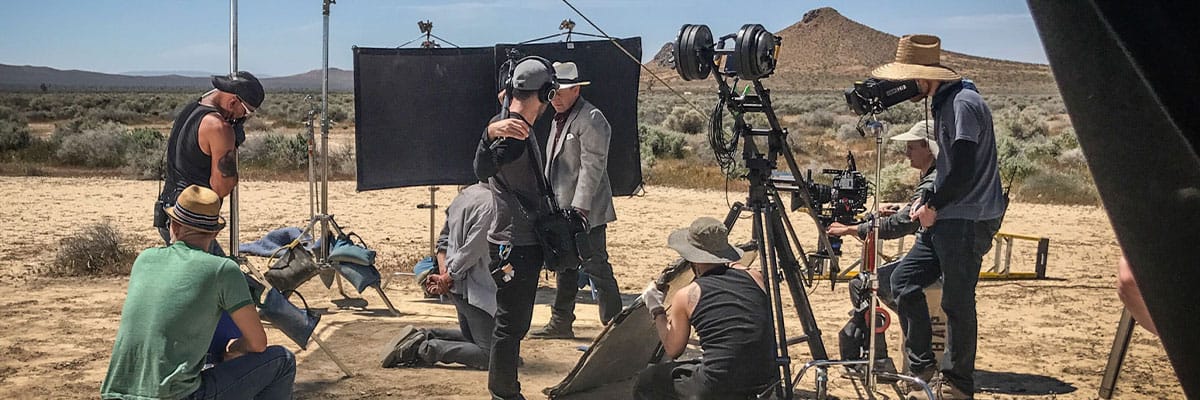
Production Life | |
|---|---|
What to Bring to Set | 9:31 |
Filmmaker’s Toolkit | 10:40 |
Proper Set Etiquette and Behavior | 15:44 |
Working with Difficult Personalities | 22:56 |
Walkie Talkie Etiquette | 14:59 |
A Day on Set | – |

Audio Recording | ||
|---|---|---|
The Physics of Sound | 25:33 | |
How Microphones Work | 21:56 | |
Microphone Pick-Up Patterns | 18:55 | |
Audio Pre-Production | 26:36 | |
Lavalier Microphones | 18:18 | |
The Microphone Boom | 17:29 | |
Boom Operating Techniques on Set | 20:36 | |
How to Record Audio on Location | 23:02 | |
Recording the Audio | 35:09 | |
Audio Configurations | 20:00 | |
Working with Cables and Adapters | 19:18 |
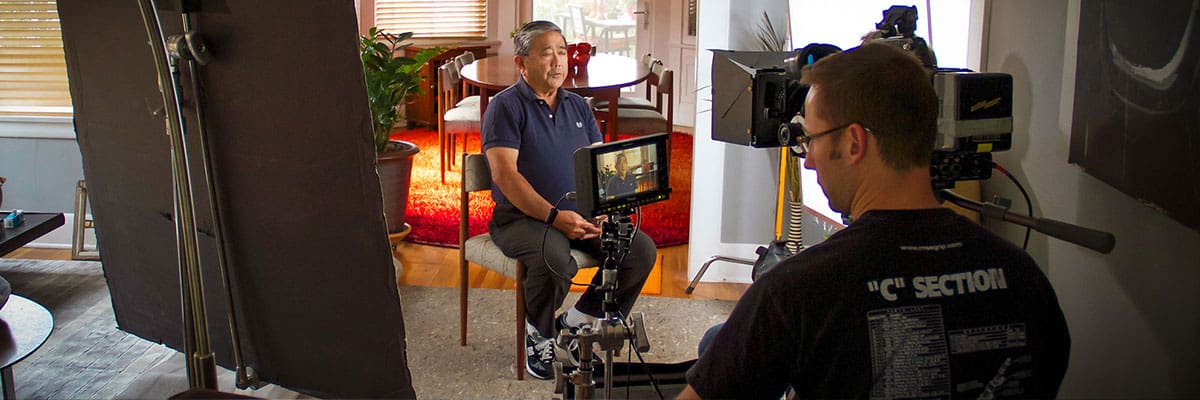
Documentary Filmmaking | ||
|---|---|---|
Introduction to Documentary Filmmaking | 24:51 | |
Finding the Story | 28:18 | |
Documentary Pre-Production | 18:51 | |
Choosing the Right Gear | 32:08 | |
Finding the Interview Location | 18:53 | |
Interview Camera Set-Ups | 25:05 | |
Preparing for the Interview | 33:03 | |
How to Conduct an Interview | 32:05 | |
Ethics and Objectivity | 21:37 | |
How to Shoot Amazing B-Roll Footage | 21:52 | |
Field Shooting Techniques | 20:17 | |
Editing a Documentary | 28:41 |
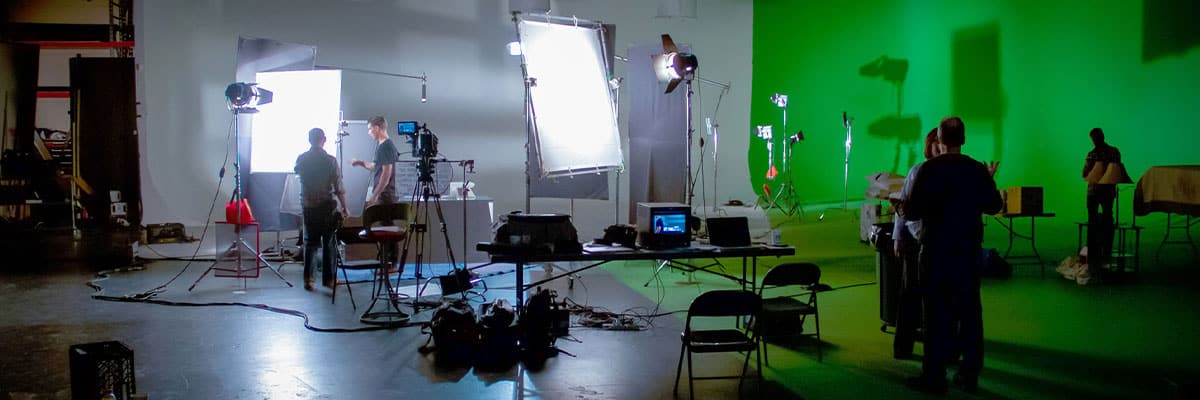
Safety Training | ||
|---|---|---|
The Attitude of Safety | 20:45 | |
Basic On Set Safety | 34:49 | |
Equipment Use and Safety | 18:47 | |
On Location Safety | 20:32 | |
Studio Facilities Safety | 24:14 | |
Vehicle and Roadway Safety | 21:13 | |
Shooting Moving Vehicles | 19:34 | |
Lighting Equipment Safety | 26:46 | |
Grip and Rigging Safety | 30:36 | |
Electrical Safety I | 39:10 | |
Electrical Safety II | 29:51 | |
Lifts, Trucks, and Tools | 24:25 | |
Weapon and Prop Safety | 29:08 | |
Pyrotechnics and Special Effects | 24:06 | |
Environmental Safety | 25:45 |
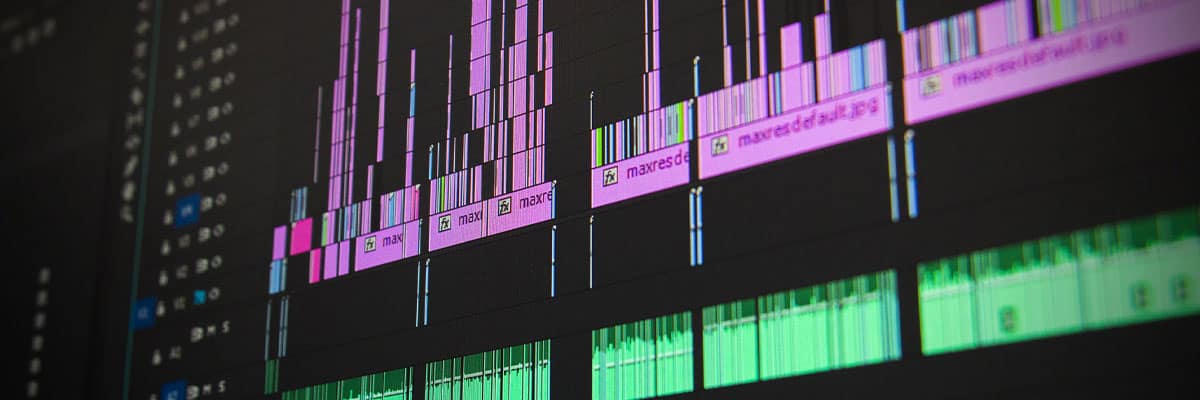
Get an inside look into the technical and artistic process of the post production process. Lessons cover data management and workflow, working with producers and clients, the art of the edit, plus the process of audio mixing and scoring.
Editing | |
|---|---|
Introduction to Editing | – |
Hiring an Editor | 10:46 |
Working with an Editor | 20:23 |
Concepts of Editing | 37:39 |
Data Management and Workflow | 26:39 |
The Assembly Cut | 21:33 |
Stock Footage | 20:58 |
How to Edit a Dialogue Scene | 34:27 |
Editing Action | 24:56 |
The Rough Cut | 19:04 |
Test Screenings | 21:34 |
The Fine Cut | 14:44 |
Online and Offline Editing | 8:28 |
Color Grading | 15:40 |
Understanding Compression | – |
Audio Post-Production | |
|---|---|
Intro to Audio Post Production | 24:49 |
ADR | 30:31 |
Directing Actors in ADR | 28:19 |
Foley | 33:33 |
Sound Effects | 24:49 |
Mixing the Audio | 31:18 |
Music Composition | |
|---|---|
Emotion Through Music | 28:25 |
The Who and How of Music | 31:29 |
Working with a Composer | 47:33 |
Music Licensing | 33:15 |

Learn the marketing and distribution process of a movie. These lessons can be paired with the producing and screenwriting lessons. This series of lessons is intended to demystify the distribution process and help you understand the business of filmmaking, what distributors are seeking, and how to identify and reach the target audience.
Film Marketing | |
|---|---|
Film Marketing | 15:41 |
Reaching Your Audience | 26:05 |
Designing the Key Art | 16:11 |
Making a Movie Trailer | 27:23 |
Building Your Website | 5:43 |
Building a Press Kit | 13:35 |
Working with the Media | 17:56 |
Distribution | |
|---|---|
Introduction to Distribution | 32:55 |
Film Ratings and the MPAA | 14:09 |
Domestic Distribution | 23:32 |
Foreign Distribution | 37:19 |
Mistakes Filmmakers Make at Film Festivals | 30:05 |
Film Festivals | 26:46 |
Online Distribution | 27:34 |
Note: The DIT course content is not included in FilmSkills Unlimited because it is produced by another content creator











Over 125 top film schools added FilmSkills to their curriculum
- UCLA
- NYU
- Emerson College
- Chapman University
- Ithaca College
- Quinnipiac University
- Yale University
- Dartmouth College
- Full Sail
- University of Notre Dame
- Waldorf University
- University of Colorado

Free Bonuses and Discounts
Get even more with FilmSkills Unlimited
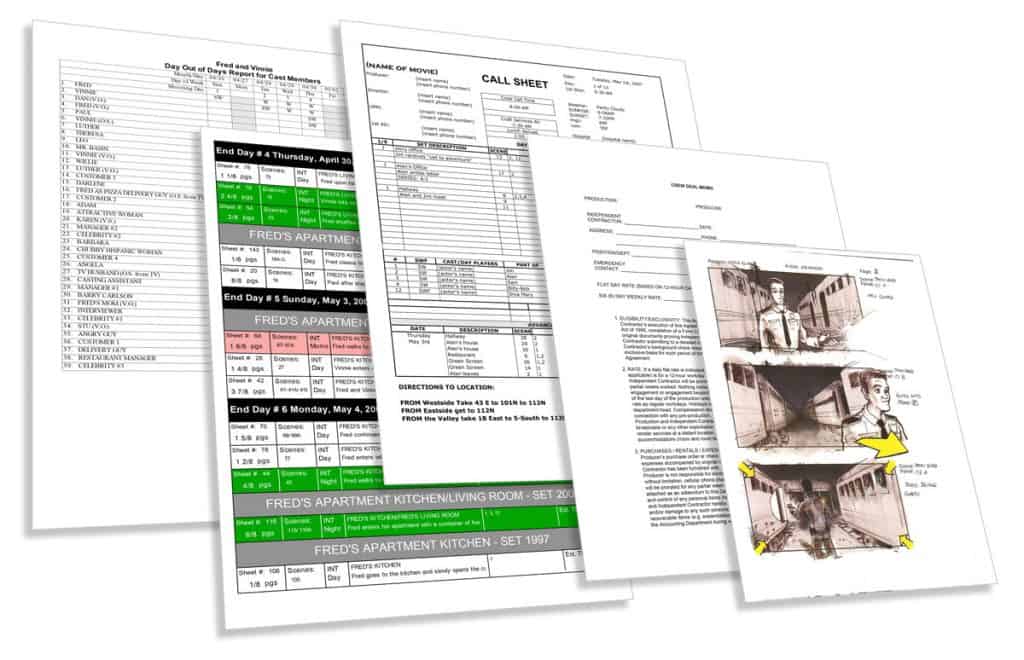
FREE Contract and Form Library
Download hundreds of call sheets, budget templates, sound logs, crew deal memos, equipment rental forms… basically every form you may ever need. PLUS the storyboards, call sheets, directors notes, script notes, and much more from Emmy-winning directors, producers, and writers. See how the pros do it.
$149 Value – FREE
PLUS All 6 FILMSKILLS REFERENCE GUIDES - FREE
1,946 pages of knowledge at your fingertips
As a FilmSkills Unlimited Member, you will also receive all 6 comprehensive FilmSkills reference guides. Quickly access screenwriting, cinematography, production safety, producing, editing, and directing techniques.
$199 Value – FREE
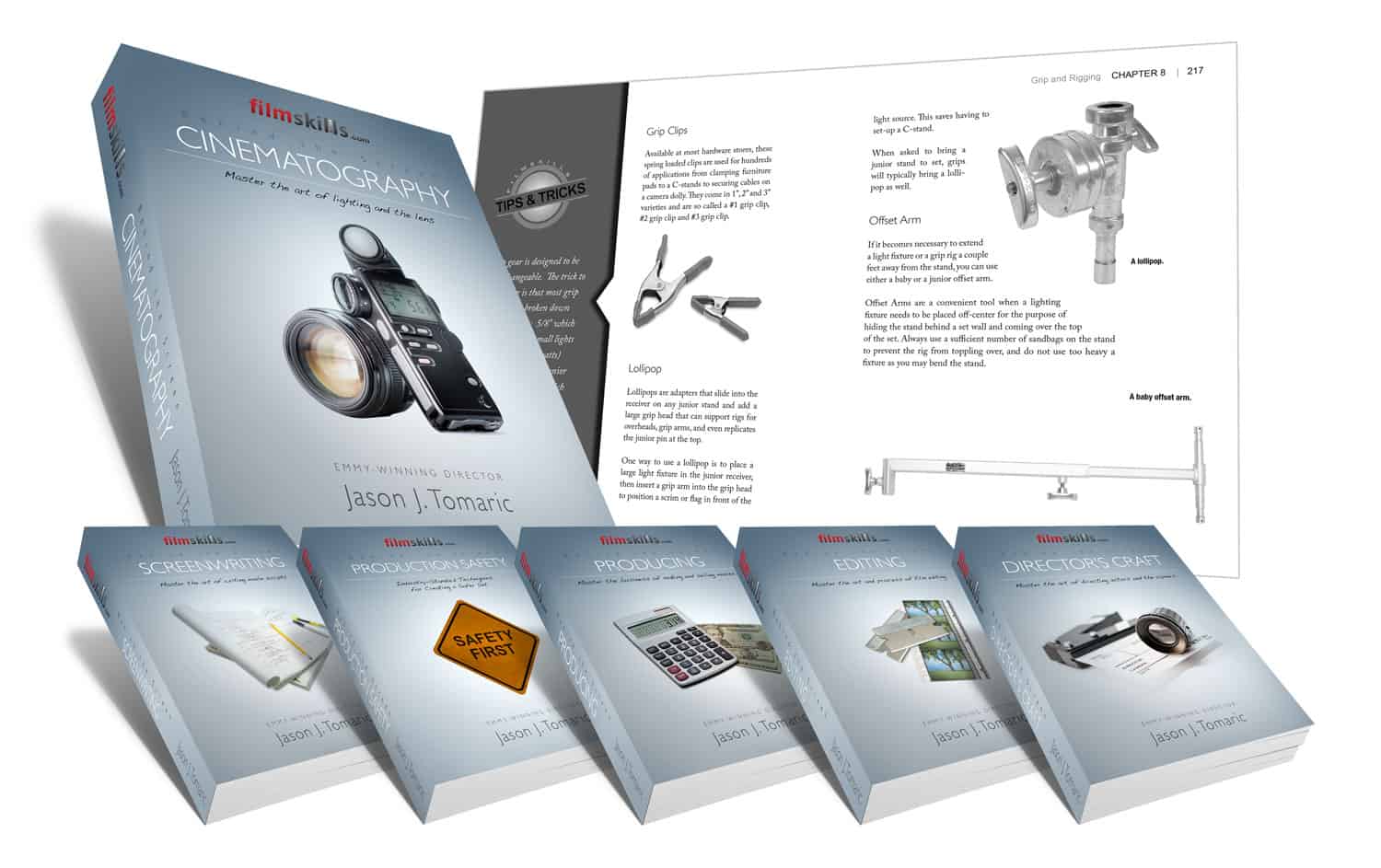


- Includes the content from all 12 FilmSkills Courses
- Includes 75 FREE bonus lessons
- 325 Filmmaking Tutorials
- 120+ Hours of Video
- Learn from 70 Academy Award and Emmy winning filmmakers
- Over 200 Downloadable Contracts and Forms
- Career and Technical Skills
- FREE access to all new content
- FREE access to all updates
- 6 FREE reference guides, packed with 1,946 pages of info
Quentin Miles
Filmmaker, Brutha' Q Filmz
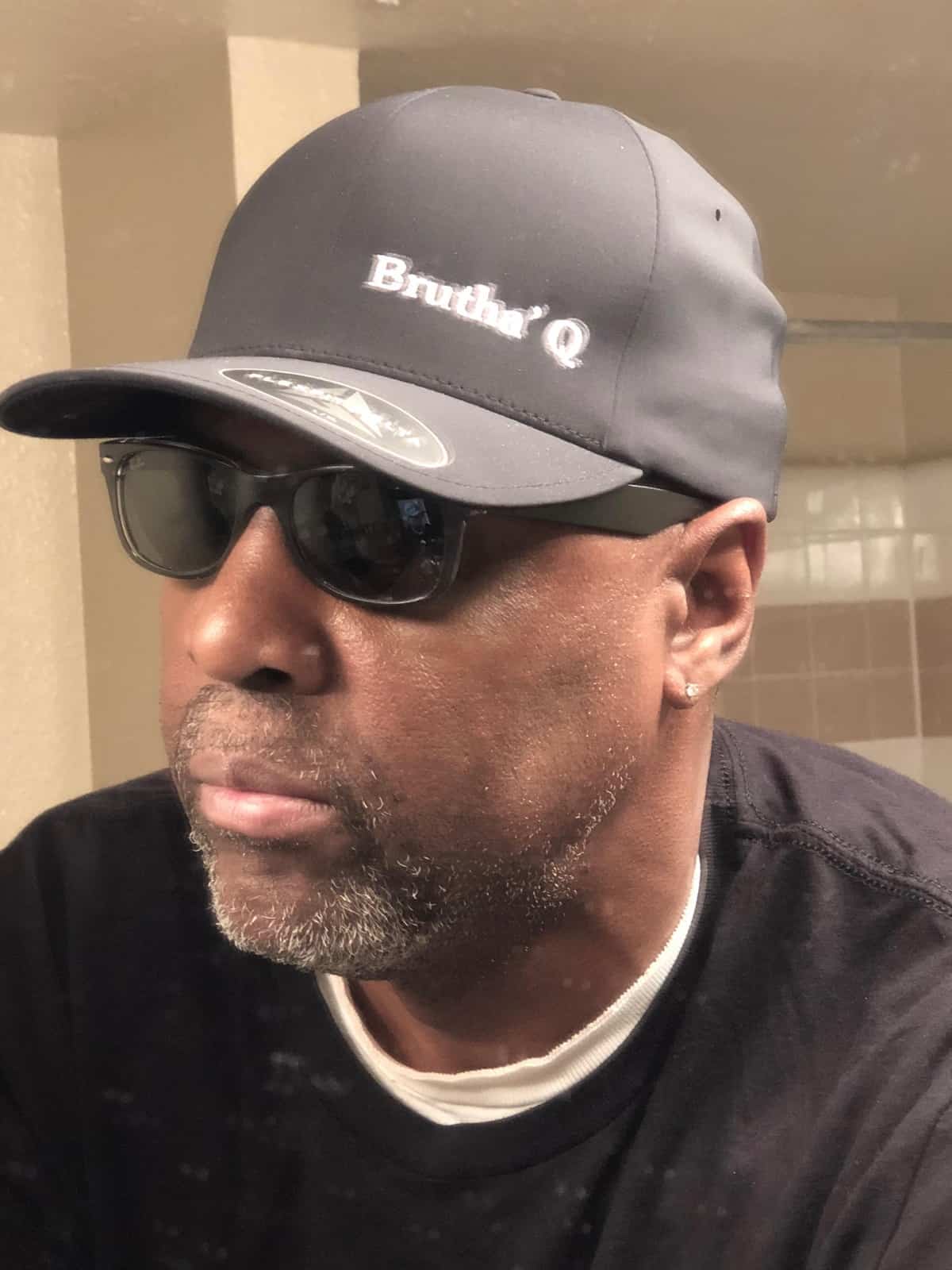

MovieMaker Magazine ranked FilmSkills among the top 10 game-changing companies for independent filmmakers.
"It's difficult to think of a step in the process that FilmSkills fails to address."
– American Cinematographer Magazine
"FilmSkills is as good as it can possibly get. You’ll be hard-pressed to find a better online program than FilmSkills."
– Mike Flanagan, Microfilmmaker Magazine
Save over 70% with

- Lifetime access to the entire FilmSkills library
- PLUS... 75 FREE bonus lessons
- PLUS... Get all new content FREE
- PLUS... Personal training
- PLUS... 6 FREE reference books
Frequently Asked Questions
When does this course start?
It start as soon as you sign up, and it’s open to you forever. And, you can access the FilmSkills content on any desktop, laptop, or tablet.
Do I really get to keep it for life?
Sure do… and not just the current content, but all the future content we produce… and we have a lot coming.
Can I preview the content?
Of course! You can watch some of the FilmSkills content on our FREE Training page, which you can explore here.
Can I get personal tutoring?
Absolutely! Jason is always available to answer your questions via e-mail,, and he usually gets back you within a day or so, depending on his shooting schedule.
Can I get certified?
FilmSkills Unlimited offers library access to the same content lessons as the courses, however, there is no certification component.
What is the difference between the Certification Courses and FilmSkills Unlimited?
FilmSkills Unlimited provides library access to the same content lessons as the courses. Whereas courses offer tests and a Certificate of Completion, FilmSkills Unlimited is designed as library access, so you can access the lessons whenever you want.
Is the DIT Course included?
No, the DIT course is produced by a third party and is not part of the FilmSkills content library. As such, it is not included in FilmSkills Unlimited and must be purchased separately.